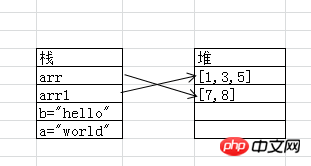Home >Web Front-end >JS Tutorial >Detailed example of how to store primitive values and reference values in JS
The original value refers to the value representing the original data type, also called the basic data type, and the reference value refers to the value of the composite data type. Next, I will introduce to you how to store original values and reference values in JS through sample code. Friends who are interested should take a look.
In ECMAscript, variables can store two types of values, namely original values and Reference value
The original value refers to the value representing the original data type, also called the basic data type, including: Number, Stirng, Boolean, Null, Underfined
Reference values refer to values of composite data types, including: Object, Function, Array, Date, RegExp
Depending on different data types, some variables are stored on the stack , some are stored in the heap. The specific differences are as follows:
Original variables and their values are stored in the stack. When passing one original variable to another original variable, the contents of one stack room are copied to another stack room, and this The two original variables have no influence on each other.
The reference value stores the name of the reference variable on the stack, but stores its actual object in the heap, and there is a pointer pointing from the variable name to the actual object stored in the heap. When the reference object is passed When giving another variable, what is copied is actually a pointer to the actual object. At this time, both point to the same data. If the value of one variable is changed through a method, when the other variable is accessed, its value will also change. Change it; but if it is not through a method but through reassignment, it is equivalent to reopening a room and the original pointer of the value changes, then the other value will not change with his change.
Look at the example:
var a="hello"; var b=a; a="world"; alert(a);//world alert(b);//hello var arr=[1,3]; arr1=arr; arr.push(5); alert(arr)//1,3,5 alert(arr1);//1,3,5 arr=[7,8]; alert(arr);//7,8 alert(arr1);//1,3,5
Use a diagram to represent the result as follows:
The values of the original variables do not affect each other. The reference variables arr and arr1 point to the same object, so when When the value of arr is changed through a method (the data in the heap room changes), the changed object will be accessed when accessing the data of arr1

through non-methods When the value of a reference variable is changed, a heap room will be re-created for the reference variable, and the pointer will also change:

Summary:
Number, Stirng, Boolean, Null, Underfined and other basic data types, their values are stored directly in the stack;
Object, Function, Array, Date, RegExp, etc. Reference types, their reference variables are stored in the stack, and pointers point to the actual objects stored in the heap
The above is what I compiled for everyone, I hope it will be helpful to everyone in the future.
Related articles:
Detailed explanation of the AJAX XMLHttpRequest object
The Django framework uses ajax to implement the batch import data function
The third implementation of writing lightweight ajax components
The above is the detailed content of Detailed example of how to store primitive values and reference values in JS. For more information, please follow other related articles on the PHP Chinese website!